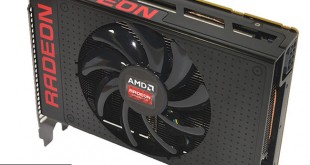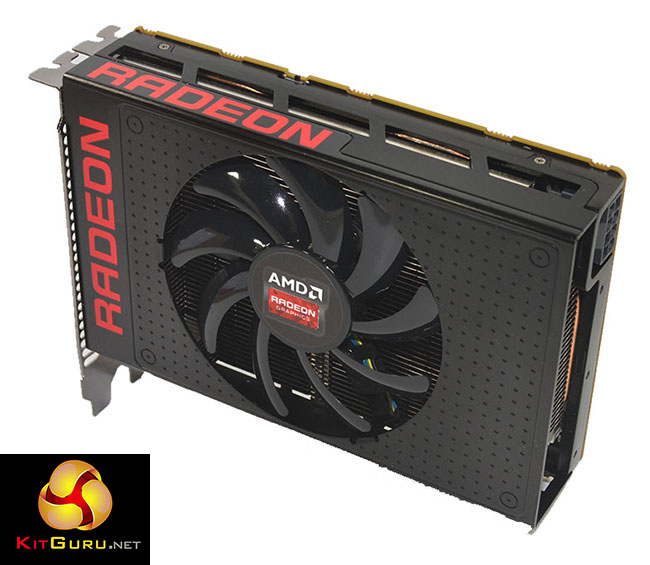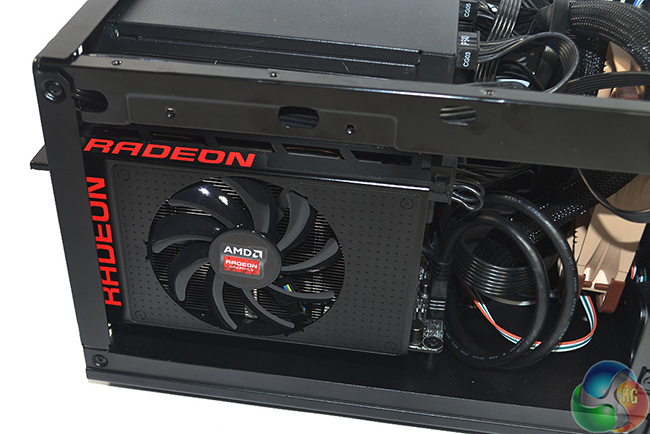
2015 has been a good year for those interested in high-performance small form factor (SFF) computing. Some of the most noteworthy releases have been ASRock's X99E-ITX/ac motherboard which brought an entirely new level of performance to consumer mini-ITX systems. And let's not forget about the array of mITX cases that we've seen from manufacturers such as Phanteks, Corsair, and Silverstone.
AMD is aiming to make its stamp on the SFF marketplace by giving gamers a graphics card based on its flagship GPU but in a mITX-capable form factor. That card is the 6-inch air-cooled R9 Nano which uses the same full-fat Fiji GPU found on the red team's flagship R9 Fury X water-cooled offering. At a little over 7.5 inches, the R9 Fury X was a small graphics card in its own right, but the Fury Nano takes over 1.5 inches off that length and mitigates installation headaches by not using the AIO liquid cooling unit.
The question that everybody is asking is ‘how will AMD's flagship Fiji GPU fair when deployed on a 6-inch air-cooled card?'
One of the most noteworthy points about the R9 Nano is that AMD deploys a full-fat Fiji GPU on the 6-inch card. Unlike the R9 Fury (non-X), there is no removal of processors or texture units when comparing the R9 Nano to AMD's flagship R9 Fury X. So how exactly is the TDP cut from 275W on the Fury X to 175W on the R9 Nano?
Firstly, the GPU Core clock is cut to a maximum of 1000MHz, which is down from the R9 Fury X's solid 1050MHz. The critical point here is the word maximum, because AMD's PowerTune algorithms dynamically adjust the actual core clock based on factors such as power usage and GPU temperature. Cutting the R9 Nano's board TDP to 175W gives the PowerTune process a target to aim at.
AMD also says that the 175W TDP is achievable thanks to the way in which the Fiji GPU scales. The chip architects have suggested that the Fiji GPU settings deployed on the R9 Nano act in the ASIC's ‘efficient' range, while the Fury X pushes the ASIC past that range in search of greater performance over core efficiency. There's also the HBM factor, which helps to shave precious Watts off the board's overall power consumption in comparison to the GDDR5 alternative.
Performance-per-inch is probably the single point that AMD would like to push with the R9 Nano. An early look at the specification sheet makes it hard to argue against that point. On paper, at least, the six-inch card opens up a whole new level of gaming performance to a SFF audience who have, up until now, been able to choose from a mini-ITX variant of Nvidia's GTX 970 as their highest-end small graphics card.
The R9 Nano's target is to give SFF gamers a miniature graphics card that is realistically capable of pushing playable frame rates at a 4K resolution without significant reductions in image quality settings. That's something that none of the current mITX-intended graphics cards on the market can realistically achieve.
But specifications and intentions don't translate into real-world performance, so let's take a look at how AMD's Radeon R9 Nano performs in the real world.
| GPU | R9 390X | R9 290X | R9 390 | R9 290 | R9 380 | R9 285 | Fury X | Fury | R9 Nano |
| Launch | June 2015 | Oct 2013 | June 2015 | Nov 2013 | June 2015 | Sep 2014 | June 2015 | June 2015 | Sep 2015 |
| DX Support | 12 | 12 | 12 | 12 | 12 | 12 | 12 | 12 | 12 |
| Process Node (nm) | 28 | 28 | 28 | 28 | 28 | 28 | 28 | 28 | 28 |
| Processors | 2816 | 2816 | 2560 | 2560 | 1792 | 1792 | 4096 | 3584 | 4096 |
| Texture Units | 176 | 176 | 160 | 160 | 112 | 112 | 256 | 224 | 256 |
| ROP’s | 64 | 64 | 64 | 64 | 32 | 32 | 64 | 64 | 64 |
| GPU Clock (Max) (MHz) |
1050 | 1000 | 1000 | 947 | 970 | 918 | 1050 | 1000 | 1000 |
| Memory Clock (MHz) |
6000 | 5000 | 6000 | 5000 | 5700 | 5500 | 500 | 500 | 500 |
| Memory Bus (bits) | 512 | 512 | 512 | 512 | 256 | 256 | 4096 | 4096 | 4096 |
| Max Bandwidth (GB/s) | 384 | 320 | 384 | 320 | 182.4 | 176 | 512 | 512 | 512 |
| Memory Size (MB) | 8192 | 4096 | 8192 | 4096 | 4096 | 2048 | 4096 | 4096 | 4096 |
| Transistors (mn) | 6200 | 6200 | 6200 | 6200 | 5000 | 5000 | 8900 | 8900 | 8900 |
| TDP (Watts) | 275 | 290 | 275 | 275 | 190 | 190 | 275 | 275 | 175 |
We have already taken a more in-depth look at the Fiji GPU in our review of the R9 Fury X, so head over to that page if you want to know more.
 KitGuru KitGuru.net – Tech News | Hardware News | Hardware Reviews | IOS | Mobile | Gaming | Graphics Cards
KitGuru KitGuru.net – Tech News | Hardware News | Hardware Reviews | IOS | Mobile | Gaming | Graphics Cards





Price!! AMD… I know it’s unique but you had a good opportunity to fight NVIDIA but you priced yourself too high (again).
And with their yield issues it will be priced even higher at retailers lol.
Who are you kidding?
I can’t see how they can charge the same as a Fury X and the Fury X has the added cost of watercooling.
Don’t matter on price, Gaming enthusiast’s will buy it just because of the size and performance it give’s, If people are willing to spend like 1500 for a titan X, I’m sure people will pay 1/3 of the price for the nano.
Can you cram Fury x into SFF case?
^ This, it delivers very well for the size/form factor in spades. But if anyone has the space/non ITX case to house longer cards the Nano isn’t for them, people just need to realize this and move on.
yes. Read a review somewhere (Hexus?) where they mentioned you could cram a Fury X into some mITX cases 🙂
Most mITX cases are long, to incorporate a full sized GFX card, you can for example get a Strix 980 into a Fractal Node 304. It’s only when you get down to stuff like the Coolermaster Elite 110 that an mITX card becomes necessary.
For £515 you can buy a 980Ti, unless you really needed a smaller card why would you purchase this ?
Indeed. Most of the people complaining about the niche this card lives in wouldn’t be buying one anyway, they’re just more interested in complaining about it.
Most of the complaining is from nvidia fanboys, trolls or paid shills. There is no way a sane consumer can be totally blind to the value proposition this card gives in ultra SFF compared to useless value the titan X gives when it is so overpriced for any form factor.
Of course there are some legitimate voices of dissatisfaction among those who really wanted to buy this card thinking it will be a more cut down version of Fiji chip and could be had for like 400-450 USD, those people have legit reasons to be slightly miffed but given the performance this thing shows they will quickly realize this card isn’t for them, the $549 R9 Fury is.
I would buy it with no hessitation, and I’m a full tower user.